A market correction is a decline in the price of a security, asset, or financial market by 10% or more from its most recent peak. These declines are considered a natural part of the market's cycle and a sign of its inherent volatility. Corrections are essential for maintaining balance in the market, as they help prevent financial bubbles and adjust overvalued asset prices. They can affect various levels of the financial market, from individual assets such as stocks or bonds to entire indexes or sectors and even broader markets. No asset or market is immune to corrections, as they are a regular occurrence in the financial world. The duration and frequency of corrections can vary significantly. Some corrections are short-lived, lasting only a few days, while others may persist for months or longer. On average, market corrections last between three and four months. These declines often occur unpredictably, making it challenging for investors and traders to anticipate their timing and magnitude. Economic cycles are one of the leading causes of market corrections. As economies expand and contract, markets react to the changing conditions. During times of economic growth, asset prices may become overvalued, leading to a correction as prices return to more reasonable levels. Interest rate changes can have a significant impact on market corrections. As central banks raise or lower interest rates, borrowing costs for companies and consumers are affected, leading to changes in spending, investment, and overall market sentiment. Political events, such as elections, policy changes, or international conflicts, can influence market conditions and trigger corrections. These events can create uncertainty and instability, causing investors to reevaluate their positions and leading to fluctuations in asset prices. Global market fluctuations can also cause corrections. Economic events in one country or region can ripple through the global economy, affecting markets worldwide. Examples of such events include financial crises, geopolitical tensions, and natural disasters. Company-specific issues, such as changes in management, financial scandals, or disappointing earnings reports, can lead to corrections in the stock price of the affected company. These events can also impact other companies in the same industry or related sectors. Industry trends, such as technological innovations, regulatory changes, or shifts in consumer preferences, can influence asset prices and lead to corrections. As industries evolve, some companies may struggle to adapt, leading to declining asset values. Changes in consumer behavior can significantly impact the demand for certain products and services, leading to corrections in the affected industries. These changes may be driven by factors such as demographic shifts, cultural trends, or economic conditions. Market sentiment, or the overall attitude of investors towards the market, can play a significant role in driving corrections. When market participants become overly optimistic or pessimistic, asset prices can become distorted, eventually leading to a correction. The increasing use of trading algorithms and automated trading systems can exacerbate market corrections. These algorithms often rely on technical indicators, which can lead to a self-reinforcing cycle of selling as prices decline. Overbought or oversold conditions, as measured by various technical indicators, can signal an impending correction. When asset prices reach extreme levels, they often revert to the mean, leading to a correction. Technical analysis is a popular method for identifying market corrections. This approach involves analyzing historical price and volume data to identify patterns and trends that may signal an impending correction. Common charting methods include moving averages, trend lines, and support and resistance levels. Fundamental analysis is another approach to identifying market corrections. This method involves evaluating the underlying financial health of a company or market, focusing on factors such as earnings, revenue, and valuation ratios. By comparing these metrics to historical averages, investors can identify potential overvaluation and anticipate a correction. Market indicators and signals can help investors and traders identify potential corrections. These indicators may include measures of market volatility, such as the VIX index, or sentiment indicators, such as the put/call ratio. By monitoring these signals, market participants can gain insight into the market's direction and prepare for potential corrections. Diversification is a key strategy for managing market corrections. By spreading investments across different asset classes, sectors, and regions, investors can reduce the impact of a correction on their overall portfolio. This approach helps to mitigate risk and promote long-term growth. Dollar-cost averaging is another long-term investment strategy that can help investors navigate market corrections. This approach involves consistently investing a fixed amount of money at regular intervals, regardless of market conditions. This strategy can reduce the impact of market volatility and help investors build their positions over time. Short selling is an active trading strategy that can help investors profit from market corrections. This approach involves borrowing shares of a stock and selling them, with the expectation that the stock price will decline. If the price drops, investors can buy the shares back at a lower price and return them to the lender, pocketing the difference. Options trading is another active strategy that can be used to profit from market corrections. By trading put options, which give the buyer the right to sell an asset at a specified price within a certain time frame, investors can capitalize on falling asset prices. Portfolio rebalancing is a crucial strategy for managing market corrections. This approach involves periodically adjusting the allocation of assets in a portfolio to maintain the desired level of risk and return. Rebalancing can help investors stay on track with their investment goals and take advantage of buying opportunities during corrections. Maintaining cash reserves and practicing sound risk management are essential for navigating market corrections. Cash reserves provide flexibility, allowing investors to take advantage of buying opportunities, while risk management strategies help minimize the potential impact of market declines. Market corrections can create value investing opportunities, as undervalued assets may become even more attractive during a correction. By identifying and purchasing fundamentally sound assets at discounted prices, investors can potentially achieve above-average returns over the long term. Contrarian investing is another approach to capitalizing on market corrections. This strategy involves going against the prevailing market sentiment, buying assets when others are selling and selling when others are buying. By taking a contrarian stance, investors can take advantage of market inefficiencies and potentially profit from market corrections. One of the primary risks associated with market corrections is the potential loss of capital. As asset prices decline, investors and traders may see the value of their holdings decrease, resulting in potential financial losses. Market corrections can lead to emotional decision-making, as investors and traders may panic or become overly pessimistic. Emotional reactions can result in poor investment decisions, such as selling assets at the bottom of a correction or failing to take advantage of buying opportunities. Another risk during market corrections is the possibility of further market declines. While a correction is generally considered a temporary decline, it can sometimes be the precursor to a more prolonged bear market. A bear market is defined as a prolonged decline in asset prices, typically characterized by a 20% or more drop from recent highs. Bear markets can last for several months or even years and often coincide with periods of economic contraction. The main difference between corrections and bear markets is the magnitude and duration of the decline. Corrections are generally shorter in duration and less severe than bear markets. Understanding the differences between these market stages is essential for developing appropriate investment strategies. Recognizing the various market stages, such as corrections and bear markets, can help investors and traders make more informed decisions. By understanding the characteristics and potential implications of each stage, market participants can better manage risk and take advantage of opportunities that arise during different market conditions. Market corrections are a critical component of the financial market, providing balance by preventing financial bubbles and adjusting overvalued asset prices. They can be triggered by a range of macroeconomic, microeconomic, and technical factors, and their unpredictability underscores the importance of robust investment strategies. Market corrections also offer potential opportunities, such as value investing and contrarian investing, which can yield above-average returns when employed wisely. However, they carry risks, including potential capital loss and the temptation for emotional decision-making. By understanding the nuances between different market stages, like corrections and bear markets, investors can implement effective strategies such as diversification, dollar-cost averaging, portfolio rebalancing, and risk management to navigate these fluctuations. Overall, a comprehensive understanding of market corrections not only enables investors to better manage risks but also seize opportunities for potential growth.What Is Correction?
Causes of Corrections
Macroeconomic Factors
Economic Cycles
Interest Rate Changes
Political Events
Global Market Fluctuations
Microeconomic Factors
Company-Specific Issues
Industry Trends
Changes in Consumer Behavior
Technical Factors
Market Sentiment
Trading Algorithms
Overbought or Oversold Conditions
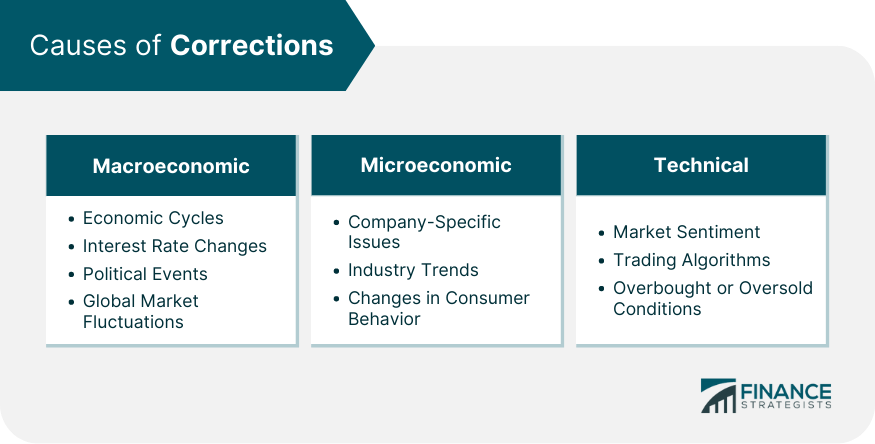
Identifying Corrections
Charting Methods and Technical Analysis
Fundamental Analysis
Market Indicators and Signals
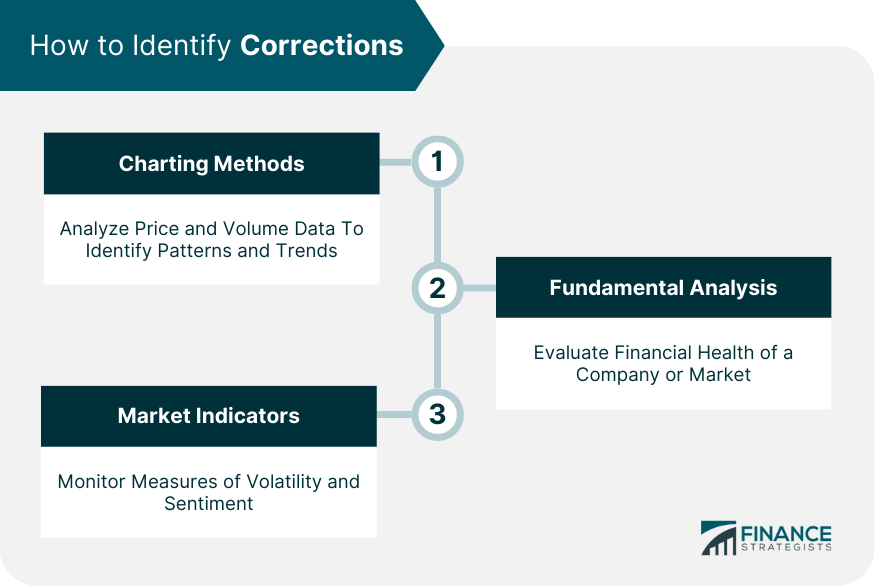
Strategies to Manage Corrections
Long-Term Investment Approach
Diversification
Dollar-Cost Averaging
Active Trading Strategies
Short Selling
Options Trading
Portfolio Rebalancing
Risk Management
Cash Reserves
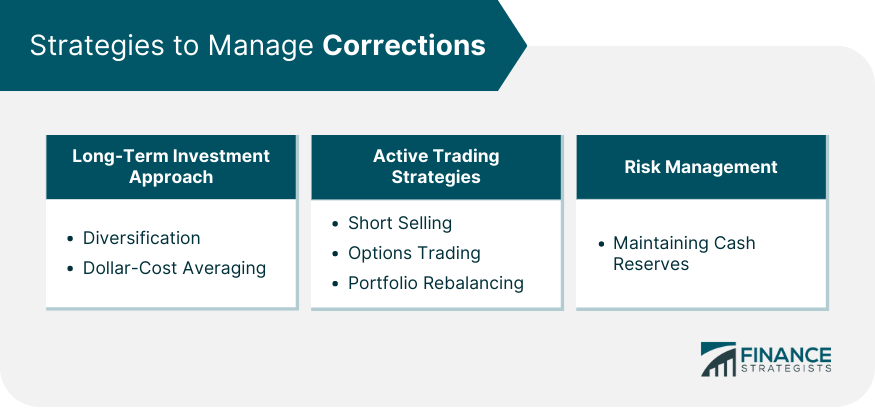
Opportunities and Risks in Corrections
Buying Opportunities
Value Investing
Contrarian Investing
Risks for Investors and Traders
Loss of Capital
Emotional Decision-Making
Potential for Further Market Declines
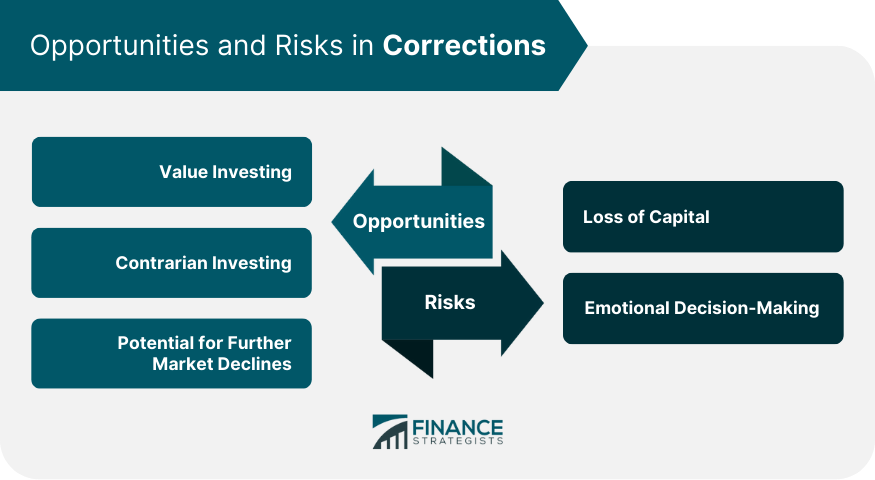
Correction vs Bear Market
Definition of Bear Market
Key Differences Between Corrections and Bear Markets
Importance of Understanding Market Stages
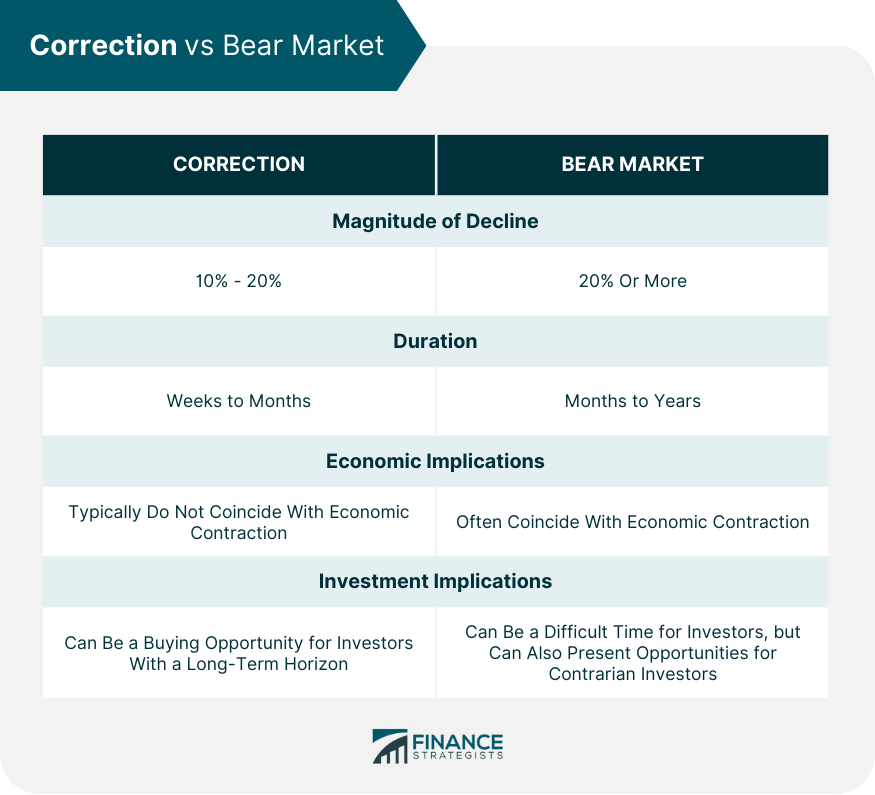
Final Thoughts
Correction FAQs
A market correction is a decline of 10% or more in the price of a security, asset, or financial market from its most recent peak.
The average market correction lasts between three and four months, although the duration can vary significantly.
Market corrections can be triggered by macroeconomic factors, microeconomic factors, or technical factors, such as economic cycles, company-specific issues, or market sentiment.
Investors can manage the risks of market corrections through strategies such as diversification, dollar-cost averaging, portfolio rebalancing, and maintaining cash reserves.
A market correction is a temporary decline of 10% or more, while a bear market is a prolonged decline of 20% or more, typically lasting several months or years.
True Tamplin is a published author, public speaker, CEO of UpDigital, and founder of Finance Strategists.
True is a Certified Educator in Personal Finance (CEPF®), author of The Handy Financial Ratios Guide, a member of the Society for Advancing Business Editing and Writing, contributes to his financial education site, Finance Strategists, and has spoken to various financial communities such as the CFA Institute, as well as university students like his Alma mater, Biola University, where he received a bachelor of science in business and data analytics.
To learn more about True, visit his personal website or view his author profiles on Amazon, Nasdaq and Forbes.











